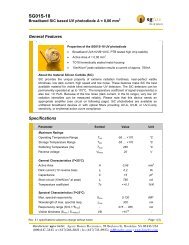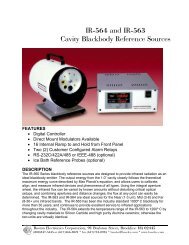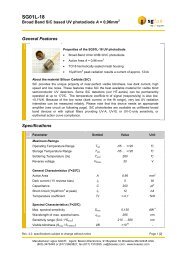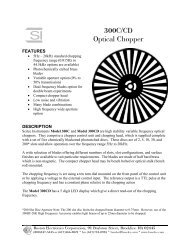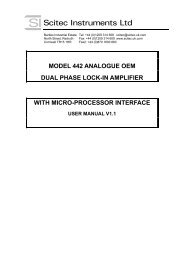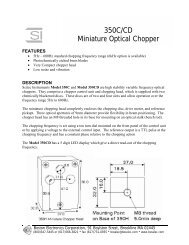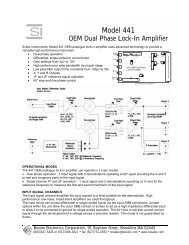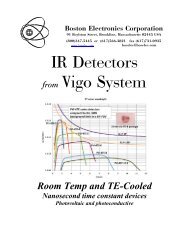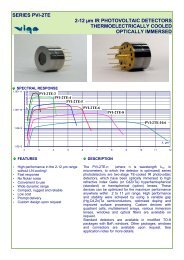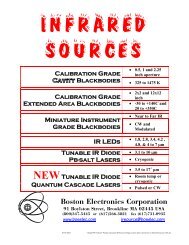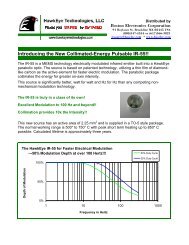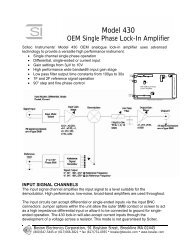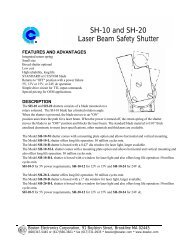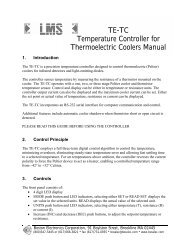TCSPC for FLIM and FRET in - Boston Electronics Corporation
TCSPC for FLIM and FRET in - Boston Electronics Corporation
TCSPC for FLIM and FRET in - Boston Electronics Corporation
You also want an ePaper? Increase the reach of your titles
YUMPU automatically turns print PDFs into web optimized ePapers that Google loves.
density is measured best by count<strong>in</strong>g the PMT pulses with<strong>in</strong> subsequent time <strong>in</strong>tervals. There<strong>for</strong>e,the application of photon count<strong>in</strong>g techniques is the logical consequence of the high ga<strong>in</strong> <strong>and</strong> thehigh speed of photomultipliers.The efficiency, i.e. the probability that a particular photon causes a pulse at the output of the PMT,depends on the efficiency of the photocathode. Un<strong>for</strong>tunately the sensitivity S of a photocathode isusually not given <strong>in</strong> units of quantum efficiency but <strong>in</strong> mA of photocurrent per Watt <strong>in</strong>cident power.The quantum efficiency QE ish c S W mQE = S ---- = ---- . 1.24 . 10 6 -----e λ λ AThe efficiency <strong>for</strong> the commonly usedphotocathodes is shown <strong>in</strong> fig. 13 (right). TheQE of the conventional bialkali <strong>and</strong>multialkali cathodes reaches 20 to 25 %between 400 <strong>and</strong> 500 nm. The recentlydeveloped GaAsP cathode reaches 45 %. TheGaAs cathode has an improved red sensitivity<strong>and</strong> is a good replacement <strong>for</strong> the multialkaliabove 600 nm.Sensitivity1000mA/WGenerally, there is no significant differencebetween the efficiency of similarphotocathodes <strong>in</strong> different PMTs <strong>and</strong> fromdifferent manufacturers. The differences are of 1300 400 500 600 700 800 900the same order as the variation betweenWavelengthnmdifferent tube of the same type. Reflectiontype cathodes are a bit more efficient than Fig. 13: Sensitivity of different photocathodes [34]transmission type photocathodes. However,reflection type photocathodes have non-uni<strong>for</strong>m photoelectron transit times to the dynode system<strong>and</strong> there<strong>for</strong>e cannot be used <strong>in</strong> ultra-fast PMTs. A good overview about the characteristics of PMTsis given <strong>in</strong> [34] <strong>and</strong> [79].10010GaAsPbia kaliGaAsmultialkaliQE=0.5QE=0.2QE=0.1Image <strong>in</strong>tensifiersImage <strong>in</strong>tensifiers are vacuum devices consist<strong>in</strong>g ofa photocathode, an acceleration <strong>and</strong>/ormultiplication system <strong>for</strong> the photoelectrons, <strong>and</strong> atwo-dimensional image detection system.First generation systems used a electron-opticalimag<strong>in</strong>g system that accelerates the photoelectronsto an energy of some keV <strong>and</strong> sends them to afluorescent screen. The image from the screen wasdetected by a traditional camera or later with aCCD camera. First generation devices had arelatively low ga<strong>in</strong> <strong>and</strong> strong image distortions.-HVPhotocathodeMultichannel PlateFluorescence ScreenCCD CameraFig. 14: Intensified CCD camera11



